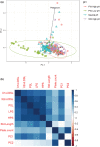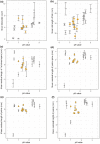Ecological constraint, rather than opportunity, promotes adaptive radiation in three-spined stickleback (Gasterosteus aculeatus) on North Uist
- PMID: 36644706
- PMCID: PMC9831901
- DOI: 10.1002/ece3.9716
Ecological constraint, rather than opportunity, promotes adaptive radiation in three-spined stickleback (Gasterosteus aculeatus) on North Uist
Abstract
The context and cause of adaptive radiations have been widely described and explored but why rapid evolutionary diversification does not occur in related evolutionary lineages has yet to be understood. The standard answer is that evolutionary diversification is provoked by ecological opportunity and that some lineages do not encounter the opportunity. Three-spined sticklebacks on the Scottish island of North Uist show enormous diversification, which seems to be associated with the diversity of aquatic habitats. Sticklebacks on the neighboring island of South Uist have not been reported to show the same level of evolutionary diversity, despite levels of environmental variation that we might expect to be similar to North Uist. In this study, we compared patterns of morphological and environmental diversity on North and South Uist. Ancestral anadromous sticklebacks from both islands exhibited similar morphology including size and bony "armor." Resident sticklebacks showed significant variation in armor traits in relation to pH of water. However, North Uist sticklebacks exhibited greater diversity of morphological traits than South Uist and this was associated with greater diversity in pH of the waters of lochs on North Uist. Highly acidic and highly alkaline freshwater habitats are missing, or uncommon, on South Uist. Thus, pH appears to act as a causal factor driving the evolutionary diversification of stickleback in local adaptation in North and South Uist. This is consistent with diversification being more associated with ecological constraint than ecological opportunity.
Keywords: North Uist; South Uist; morphometric study; stickleback.
© 2023 The Authors. Ecology and Evolution published by John Wiley & Sons Ltd.
Figures





Similar articles
-
The evolutionary ecology of dwarfism in three-spined sticklebacks.J Anim Ecol. 2013 May;82(3):642-52. doi: 10.1111/1365-2656.12028. Epub 2012 Dec 12. J Anim Ecol. 2013. PMID: 23237226
-
Spatial heterogeneity in pH, body size and habitat size generates ecological opportunity in an evolutionary radiation.J Fish Biol. 2022 Dec;101(6):1501-1508. doi: 10.1111/jfb.15221. Epub 2022 Oct 7. J Fish Biol. 2022. PMID: 36134556
-
Development of resident and migratory three-spined stickleback, Gasterosteus aculeatus.PLoS One. 2024 Jul 18;19(7):e0295485. doi: 10.1371/journal.pone.0295485. eCollection 2024. PLoS One. 2024. PMID: 39024313 Free PMC article.
-
Effects of environmental variation on host-parasite interaction in three-spined sticklebacks (Gasterosteus aculeatus).Zoology (Jena). 2016 Aug;119(4):375-83. doi: 10.1016/j.zool.2016.05.008. Epub 2016 May 26. Zoology (Jena). 2016. PMID: 27289265 Review.
-
Toward conservation of genetic and phenotypic diversity in Japanese sticklebacks.Genes Genet Syst. 2016 Oct 13;91(2):77-84. doi: 10.1266/ggs.15-00082. Epub 2016 Jun 10. Genes Genet Syst. 2016. PMID: 27301281 Review.
References
-
- Barrett, R. D. , Rogers, S. M. , & Schluter, D. (2008). Natural selection on a major Armour gene in threespine stickleback. Science, 322(5899), 255–257. - PubMed
-
- Barrett, R. D. , Rogers, S. M. , & Schluter, D. (2009). Environment specific pleiotropy facilitates divergence at the Ectodysplasin locus in threespine stickleback. Evolution: International Journal of Organic Evolution, 63(11), 2831–2837. - PubMed
-
- Barrier, M. , Baldwin, B. G. , Robichaux, R. H. , & Purugganan, M. D. (1999). Interspecific hybrid ancestry of a plant adaptive radiation: Allopolyploidy of the Hawaiian silversword alliance (Asteraceae) inferred from floral homeotic gene duplications. Molecular Biology and Evolution, 16(8), 1105–1113. - PubMed
-
- Bell, M. A. , & Foster, S. A. (1994). The evolutionary biology of the three‐spine stickleback. Oxford University Press.
-
- Bell, M. A. , Ortí, G. , Walker, J. A. , & Koenings, J. P. (1993). Evolution of pelvic reduction in threespine stickleback fish: A test of competing hypotheses. Evolution, 47(3), 906–914. - PubMed
LinkOut - more resources
Full Text Sources

